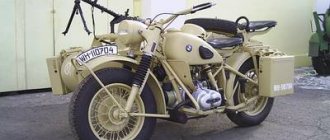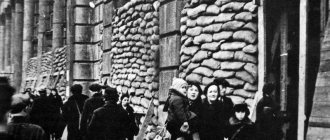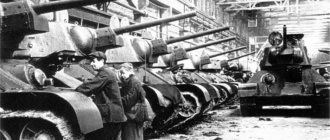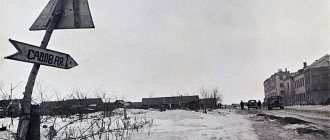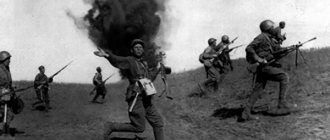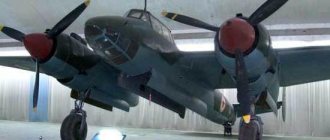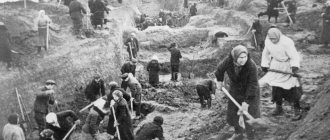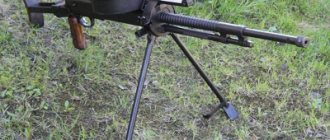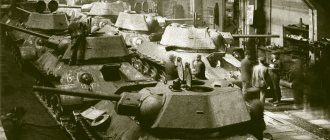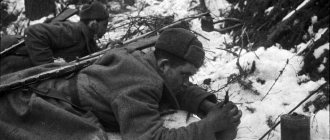Red cavalry on the threshold of the Great Patriotic War: the number and organization of the Red Army cavalry
By the end of the 1930s, cavalry units existed in all European states, and although the First World War seriously “undermined the prestige” of cavalry, service in the cavalry was an honorable thing not only in the USSR and Poland, but also in France and Germany . where the cavalry constituted a rather impressive force.
At the beginning of the Second World War, the Red Army had the most powerful and effective cavalry. However, looking at how events were developing in the West, where even the most well-trained cavalry units were unable to provide significant resistance to armored forces and were completely defenseless from aviation, the leadership of the Red Army decided to immediately and very radically reduce the share of cavalry in the army.
Already in 1939-1940. Ten cavalry divisions and a separate cavalry brigade were disbanded, the personnel of which became part of the formed formations of armored forces. Thus, by the beginning of the Great Patriotic War, the Red Army consisted of:
- 4 cavalry corps directorates
- 9 cavalry divisions
- 4 mountain cavalry divisions
- 4 reserve cavalry regiments
- 2 reserve mountain cavalry regiments
- 1 reserve cavalry artillery regiment.
Three cavalry corps included two cavalry divisions, and one, in addition, had a mountain cavalry division. Unlike the rifle corps, the cavalry corps did not have any special units other than the communications division.
The cavalry division of the Red Army had a strength of 8968 people (number of horses: 7625) and included:
- 4 cavalry regiments.
- 1 horse artillery division consisting of two four-gun batteries of 76 mm cannons and two four-gun batteries of 122 mm howitzers.
- 1 tank regiment consisting of four squadrons of BT-7 tanks (64 vehicles).
- 1 anti-aircraft division consisting of two batteries of 76-mm anti-aircraft guns and two batteries of anti-aircraft machine guns.
- 1 communications squadron.
- 1 sapper squadron.
- 1 degassing squadron.
- Support units.
The cavalry regiment of the Red Army numbering 1428 people consisted of:
- 4 saber squadrons.
- 1 machine gun squadron (16 heavy machine guns and 4 mortars of 82 mm caliber).
- regimental artillery (4 76 mm guns and 4 45 mm guns).
- anti-aircraft battery (3 37-mm guns and three M-4 machine gun mounts).
- half-squadron of communications.
- sapper platoon.
- chemical platoon.
- support units.
Unlike the cavalry division, the mountain cavalry division, numbering 6,558 people, did not have a tank regiment; its artillery batteries were armed with only 26 mountain cannons of 76 mm caliber and mountain mortars of 107 mm caliber. The number of horses in this division is 6827.
All cavalry units were maintained in peacetime according to staffs that were practically no different from wartime staffs, and were well staffed with trained personnel.
Cavalry attack of the Red Army, Great Patriotic War
Formed on December 16, 1941 on the Southern Front as part of the 35th, 56th, 68th divisions. Originally called Separate.
By mid-December, the corps concentrated in the Dyakovo area in the reserve of the Southern Front. Additionally, 68kd was included in the OKC. There were 5899 people in three divisions, of which 1500 people were in combat units... the rest were special units and rear services. The corps' artillery consisted of 11 guns and 49 machine guns. machine guns, 25 82mm mortars, 39 50mm mortars.. On December 20, the 35kd consisted of 1883 people, 56kd 1993 people. Units of the Southern Front carried out offensive operations in the Artemovsk and Gorlovka directions. 18A was supposed to advance in the direction of Chistyakovo (Torez) and Alekseevo-Orlovka. OKK was intended to build on the success of entering the 296th and 136th divisions. Also, the 2nd brigade was involved in the offensive as mobile reserves. Italian units of the Celere division defended in this area. Having gone on the offensive on December 25, counting on the breakthrough created by the infantry, 35kd in the Mikhailovka area was attacked by 19 tanks from Petropavlovka. Under the cover of 4 tanks of the 2nd Tank Brigade, the division retreated in disarray to the Orlovo-Ivanovka area. The 68th Tank Brigade on the morning of December 26 was also counterattacked in the Petropavlovka area by tank units. In the morning, German aircraft appeared in the sky, delivering deadly strikes. 56kd remained in the second echelon and suffered fewer losses. The 136sd infantry did not approach. The units that broke through were cut off by enemy tanks, and those who suffered heavy losses of 35 and 68 kd began to withdraw in small groups at ref. frontiers. Losses of 35kd for December 25-26 amounted to 1139 killed and missing, 4 76mm guns. 166kp remained surrounded. Some of the people and horses were later collected. 68kd lost 128 killed and wounded. 56kd 195 killed, wounded and missing. The battles took place in conditions of a strong snowstorm and wet snow that covered all the roads. The overall result of the unsuccessful operation was the withdrawal of the German 168th Infantry Division in the Krasny Luch area beyond the Miuss River. On December 29-31, the enemy launched a counteroffensive, capturing Kulinatsky. On the night of December 30, 18A restored the situation with an attack. 35, 56, 68kd attacked together with 296d and 136d.
From January 1, 42 The corps was transferred to the front reserve. Having completed a 45 km march in conditions of a severe snowstorm and 30 degree frost, parts of the corps concentrated in the Petrovo-Krasnoselye area. The march was difficult for the cavalrymen. There were almost 500 frostbite victims, and vehicles lagged behind. The reinforcements that arrived were not uniformed. On January 4, an order was received to transfer to the Kremennaya, Varvarovka area. The march had to be carried out in snowstorm conditions exclusively at night. By the morning of January 8, the corps concentrated in the area of the village of Lisichansk. In the indicated area, cavalry units were putting themselves in order. January 14, 42 An order was received to rename the OKC the 1st Cavalry Corps. By the morning of January 14, the corps concentrated in the Kremennaya and Karpovka areas. To strengthen the hull, 15tbr was given. Kav. units experienced great problems due to lack of food and fodder. The roads were snowy and the delivery of supplies was difficult.
Units of the Southern Front were finishing their concentration for the upcoming offensive. According to the plan of the operation, it was necessary to break through the enemy’s defenses between Balakleya and Slavyansk with the forces of the Southwestern and Southern fronts. Mobile groups of cavalry corps and tank brigades were to be introduced into the created breakthrough. According to the operation plan, these forces, having reached the Sea of Azov, were supposed to interrupt the communications of the German 17A and 1TA and, pressing them to the sea, destroy them.
On the morning of January 18, units of the Southern Front went on the offensive. The main blow was delivered by the fresh 57A of Lieutenant General Ryabyshev, which began the offensive from the Izyum-Krasny Liman line. Operators were sent to the location of the 57A rifle divisions. corps headquarters workers. By the morning of January 20, units 57A had crossed the North. Donets and advanced 20-23 km. reaching the line Velikaya Kamyshevakha, Novo-Kamyshevakha, Bazaleevka, Bobrov, Morozovka, Raigorodok. 1KK received an order to move closer to the front to the Shandrigolovo area. On January 21, units 1 and 5 of the KK received orders to enter the breakthrough. The corps was crossing the North. Donets in the Senicheno area, Studenok bypassing the resistance center in Dolgenkaya. On the right, 5KK Grechko was crossing the Donets. To strengthen Parkhomenko's hull, she was given 255 sd. On the morning of January 22, cavalry formations of the 1st KK and 15th Tank Brigade entered into battle with retreating enemy units in the Suligovka area. The offensive began in deep snow and off-road conditions. On January 22, 68kd, moving forward, started a battle for Novo-Dmitrievka. 35 and 56kd were mastered by Kurulka-1. The enemy counterattacked and again captured Kurulka. The village changed hands twice, but in the end it remained with our troops. The battles in Kurulka took place in severe frost conditions. There were 248 frostbite cases in the two divisions. Up to 40 enemy trucks and many other trophies were captured. However, leaving Kurulka, enemy units retreated to the Barvenkovo-Slavyansk railway line, holding the north. its populated areas, preventing our further advance to the south. Meanwhile, the right-flank 5KK Grechko captured Barvenkovo by the morning of January 24. Units of 1KK, together with the approaching 255th and 349th SD 57A, fought for Veselovka and Novo-Alexandrovka (eastern Barvenkovo).
On January 26, the corps was ordered to leave the battle and follow its units through Barvenkovo to the south through the breakthrough created by the 5KK units. 5KK was supposed to develop success in the southern direction to Krasnoarmeyskoye, and 1KK was supposed to strike from the rear at the Kramatorsk enemy group. By the morning of January 26, 56kd reached Ocheretino (10 km south of Barvenkovo) where it encountered enemy fire resistance, 35kd reached Andreevka, 68kd reached Golubovka. Until the morning of January 28, the corps fought for Ocheretino. It was impossible to get around the village due to the lack of roads. A snowstorm was raging, covering all the roads. Motor transport lagged behind due to snow drifts and the cavalrymen experienced a lack of food, ammunition and fodder. 15tbr lost all its mats on the roads due to breakdowns. Part. There are only 2 T-34s and 4 T-60s left. To ref. On January 28, Ocheretino was captured. In the battles of January 25-27, the headquarters of the 54th and 457th infantry regiments and documents of the defeated 257th enemy infantry division were captured. The corps was tasked with reaching Sergeevka and Novo-Alexandrovka on the approaches from the west to Kramatorsk and Druzhkovka. 68kd occupied Yavlenskoe but was knocked out by a counterattack. In the battle, the commander of the 68kd, Colonel Kirichenko, was seriously wounded and died on February 2. 56kd approached Shavrovo and Elizavetovka, 35kd approached Gromovaya Balka. Heavy fighting began again for these settlements. The enemy brought units of 97 and 101LPD reinforced with tanks here from Donbass along snow-covered roads. The enemy units stubbornly resisted, realizing the threat that our cavalry entered the communications of the Donbass group. Our troops had practically no ammunition due to snow drifts. 255sd was used to strengthen the body. Tankers of the 15th brigade continued to repair their tanks in the Barvenkovo area.
By January 29, the corps was fighting at the Yavlenskaya-Mikhailovka line. On January 30, units of the corps, together with the 255th Rifle Division, captured Yavlenskaya and the south. part of Mikhailovka. The infantry battalion was defeated and the enemy's convoy was captured. The Germans transferred reserves to Mikhailovka and held it. The weather improved and German aircraft appeared in the sky. The enemy was clearly gaining strength, launching counterattacks using tanks. In the Krasnoarmeyskoe area, Hube's group from units of the 16th Division was finishing its concentration. The corps in battles since January 20 lost 2,136 people and 460 horses. Trophies for the same period included 22 field guns, 2 artillery guns, many vehicles and small arms. As of February 1, the corps numbered 5151 people, of which 1414 people. in combat units. It was armed with 14 76mm, 6 45mm guns, 23 82mm, 35 50mm mortars, 69 rrpd, 85 ppd, 23 machine guns. machine gun.
On February 1, an order was received from the headquarters of the Southern Front. The corps was ordered to change the direction of action in order to help the 5th KK, which was operating on the approach to Krasnoarmeyskoye. The Hube group went on the offensive against the 5KK units and on February 3, Grechko’s corps began retreating to the north. direction to Aleksandrovka. The operation to break through to the Sea of Azov with the help of cavalry units was unsuccessful and now units of the Southern Front had to repel a counterattack by enemy units. 1 KK acted on the flank of the advancing enemy group in the area of Stepanovka, Novo-Alexandrovka, Blagodat. A tank group of German troops broke through in the Sergeevka area and captured Novo-Andreevo and Kuroyedovka. There was a threat of being cut off from Barvenkovo and their rear. However, the command prepared a counterattack on Sergeevka with the forces of the corps, 255th and 349th infantry divisions. 68kd was supposed to launch an attack from Bezzabotovka, 56kd from Fedorovka, 35kd from the Nikolaevka area. There were no shells or mines in the hull parts. Our troops occupied Kuroyedovka, but the attacks of 68kd and 56kd on February 6 on Stepanovka were repelled by the enemy. There was a large enemy garrison in Stepanovka. During the attack, the corps used up its entire supply of mines and 76mm shells. 35kd attacked Grace and was also unsuccessful.
On the night of February 7, a regrouping was made for a new attack on Stepanovka. By 10 a.m., 76mm shells and mines were delivered. However, the enemy’s attack on Grace, where 35kd was defending, was successful. The division was knocked out of the settlement and scattered, retreating to the storage area. Samara Stovki, and then to Mikhailovka. On February 8, 56, 68 and the approaching 66kd again launched an attack on Stepanovka. On the morning of February 10, the Germans with tanks launched an attack from Stepanovka to Sergeevka and Fedorovka. 35kd was knocked out of Fedorovka and retreated to Novo-Andreevka, and the corps also had to leave Kuroyedovka. On February 10, the corps numbered: 35kd 634 people, 56kd 1274 people, 68kd 1488 people.
On the night of February 11, the corps went on the defensive at the Mikhailovka, Andreevka, Novo-Stepanovka line. By the middle of the day, German troops managed to capture Mikhailovka with an attack by tanks and motorized infantry. Attempts by 1st KK units to recapture Mikhailovka and Novo-Andreevka on February 12 were unsuccessful. 68kd left Bezzabotovka having suffered heavy losses. On February 14, the German tank group captured Andreevka. German troops broke through the defenses of 5KK, building on their success at Barvenkovo from the south. To create a flank threat to the enemy group, a group of corps units, 15th brigade and 255th rifle division was concentrated. Severe frosts and snowstorms gave way to a thaw, as a result of which the roads were again broken.
On February 15, German troops again attacked parts of the corps and captured Gromovaya Balka. 66kd was subjected to an attack by 4 tanks after a heavy night battle for Andreevka and after the battle began a disorderly retreat to Gromovaya Balka. 56kd went to Ocheretino. 68kd remained in reserve. On February 16, the left flank 349th Rifle Division was attacked, leaving Elizavetovka and Fidlerovo. Developing success, the enemy attacked with 35kd, knocking it out of Fidlerovo and Golubovka. By the evening, the enemy captured Ocheretino, but with a counterattack of 56kd and 1109sp, our troops fought for Ocheretino during February 17-18, but were unable to completely capture it. The enemy strike force was unable to break through to Barvenkovo as planned by the German command, encountering the stubborn defense of 5KK units. Now units 57A, in turn, launched a counteroffensive. 1KK was reinforced by 131tbr and 23msbr. During February 19, units of the corps fought for Ocheretino. In the evening, enemy units began to retreat from Ocheretino to Gromovaya Balka. It was not possible to completely master Ocheretino. Enemy units launched a counterattack, trying to knock our units out of Ocheretino. 35kd and other parts of the hull were knocked out of Ocheretino. By 21:00 the village was again occupied by German troops. Subsequent attacks on Ocheretino on February 20-22 were unsuccessful.
On the morning of February 25, the corps was ordered to surrender the defense sector of the 23rd Motorized Rifle Brigade and go to reserve 57A in the Barvenkovo area. Corps artillery remained at the disposal of the 23rd Motorized Rifle Brigade. Upon the arrival of the corps units in the concentration area, an order was received to transfer horses and weapons to replenish the 5KK Grechko. 56, 35kd, having transferred weapons with personnel of artillery and mortar units and cavalry, 5KK entered the Novo-Dmitrievka, Novo-Pavlovka area. The divisions of the corps were intended to be reorganized into a rifle corps.
On February 26, the corps commander, Major General Parkhomenko, sent an emotional telegram to the commander of the Southwestern Front, Marshal Timoshenko: “1st KK was formed in October 41. and participated in three operations. The corps was not fully staffed and mated. partly, especially in the last operation. Despite this, the soldiers and command staff showed steadfastness and heroism in the battles, defending every inch of land with a bayonet and butt. There was no case of withdrawal without orders from high command. The history of the corps is written with the blood of the best fighters, commanders and political workers who died in battle. 5KK was created in mid-January 42. and being fully staffed and mated. partly in his first and only operation he lost his mat. Part. I believe that the right to be a cavalry corps belongs to 1KK. I ask for your petition to the government of the USSR to retain the 1st Cavalry Corps as cavalry corps. Order on the transfer of personnel and mat. Part 5KK is being completed and will be completed on February 27. Parkhomenko."
However, the order to disband the corps was not canceled. Part of the mat. parts and personnel of the 56th and 68th kd were transferred to staff the 26kd 6kk. To ref. On March 1-3, the remaining weapons and personnel were transferred to equip the 2nd and 5th KK.
Cavalry of the Red Army in the period from 1941 to 1945.
Organization of the Red Army cavalry in 1941
During the border battles of the summer of 1941, the cavalry and mountain cavalry divisions suffered such heavy losses that almost all of them had to be disbanded. Since at the same time many tank and motorized divisions were disbanded for the same reasons, there was an urgent need for mobile formations with at least some striking force.
For this reason, already in the summer of 1940, the formation of several dozen so-called light raid cavalry divisions , numbering about 3,000 people.
These divisions showed high mobility in off-road conditions and snow drifts, and therefore by the end of 1941 the Red Army already had 82 light cavalry divisions. Each of them included:
- 3 cavalry regiments (consisting of 4 saber and 1 machine gun squadrons)
- 1 artillery battery (consisting of 4 76 mm guns and 2 45 mm anti-tank guns).
The squadrons were armed with light and heavy machine guns, rifles and sabers. Divisional artillery, tanks, anti-tank and anti-aircraft weapons, communications units and sappers were not provided for in light cavalry divisions.
If we consider that the bulk of the personnel of the light divisions came from the reserves and there was no time to put together units, and the horses came from stud farms and horse farms, from pasture, completely unaccustomed to campaigns and not shod, the huge losses that Light cavalry divisions carried in battles: of the 500 thousand cavalry personnel sent to the active army in the summer and autumn of 1941, only a few survived.
Awards and honorary titles
- Order of the Red Banner - awarded by Decree of the Presidium of the Supreme Soviet of the USSR dated February 7, 1944 for the exemplary performance of combat missions of the command on the front of the fight against the German invaders and the valor and courage shown.
- “Debrecen” - the honorary name was assigned by order of the Supreme Commander-in-Chief No. 0366 of November 14, 1944 to commemorate the victory and distinction in the battles for the capture of the city of Debrecen.
Division unit awards:
- 49th Cavalry Novo-Zavolzhsky Red Banner Order of Bogdan Khmelnitsky Regiment;
- 115th Transbaikal Cavalry Order of Alexander Nevsky Regiment;
- 163rd Ulyanovsk Cavalry Order of Suvorov and Bogdan Khmelnitsky (Order of Bogdan Khmelnitsky II degree) Regiment;
- 154th Tank Order of Suvorov Regiment;
- 1668th Artillery and Mortar Regiment of the Order of Alexander Nevsky;
Compound
The division included the following units:
- 49th Cavalry Regiment;
- 115th Cavalry Regiment;
- 163rd Cavalry Regiment;
- 154th Tank Regiment (from August 2, 1943);
- 1668th artillery and mortar regiment;
- 455th separate air defense division (144th separate anti-aircraft artillery division);
- 37th (1668th) artillery park;
- 1st separate sapper squadron;
- 10th separate communications squadron;
- 12th separate medical squadron;
- 8th separate chemical defense platoon;
- 4th food transport;
- 24th Motor Transport Squadron;
- 11th repair and restoration squadron;
- 8th platoon for the supply of fuels and lubricants;
- 238th Divisional Veterinary Hospital;
- 305th field bakery;
- 138th Field Postal Station;
- 386th field cash desk of the State Bank of the USSR.
